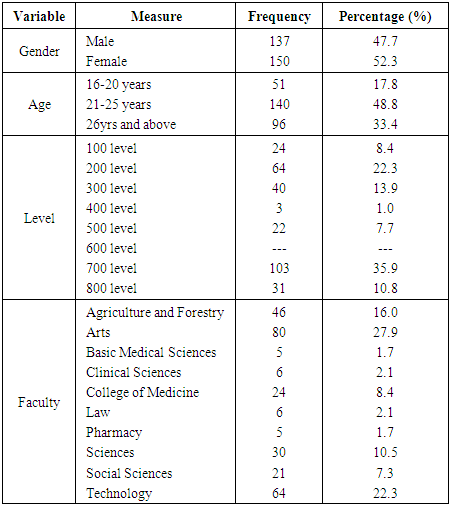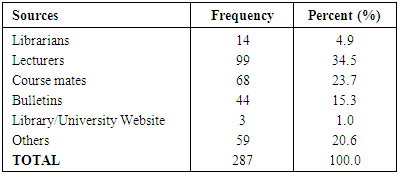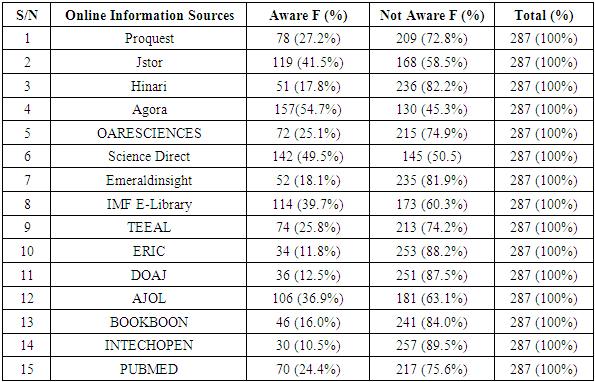-
Paper Information
- Paper Submission
-
Journal Information
- About This Journal
- Editorial Board
- Current Issue
- Archive
- Author Guidelines
- Contact Us
International Journal of Library Science
p-ISSN: 2168-488X e-ISSN: 2168-4901
2017; 6(2): 37-41
doi:10.5923/j.library.20170602.02

Awareness and Use of Online Information Sources among University of Ibadan Students
Otulugbu Dumebi
Kenneth Dike Library, University of Ibadan, Ibadan, Nigeria
Correspondence to: Otulugbu Dumebi, Kenneth Dike Library, University of Ibadan, Ibadan, Nigeria.
| Email: |  |
Copyright © 2017 Scientific & Academic Publishing. All Rights Reserved.
This work is licensed under the Creative Commons Attribution International License (CC BY).
http://creativecommons.org/licenses/by/4.0/

The internet has helped in the amassing of a large amount of information for consumption in varied fields of endeavor. This has brought about increasing ease in the search for and use of information in academic, social, political and other spheres of life. However, despite the increasing simplicity in the accessing of information, there are indications that some students do not fully utilize information sources. Thus, this study investigates the awareness and use of online information sources among university of Ibadan undergraduate students. Copies of questionnaires were administered on 300 students on purposive sampling basis. Findings show that 97.9% of the students were generally aware of online information sources but very few of the students were aware of the individual online sources that are made available in the university. In addition, very few of the students were satisfied with the available online information sources. This study suggests that university libraries should effectively create awareness about the various online resources that available for students’ usage. The findings of this study will be useful to academic institutions in the same terrain like the University of Ibadan. Also, librarians and academic scholars will find this study useful in the effective creation of awareness of online information sources among university students.
Keywords: Information Sources, Online, University of Ibadan, Awareness, Use
Cite this paper: Otulugbu Dumebi, Awareness and Use of Online Information Sources among University of Ibadan Students, International Journal of Library Science, Vol. 6 No. 2, 2017, pp. 37-41. doi: 10.5923/j.library.20170602.02.
Article Outline
1. Introduction
- In the modern world, the quest for information has become the order of the day. Information has become a necessity for everyone and everyone needs information for some purpose or the other (Kandasamy & Vinithat, 2014) [1]. There are increasing need for information in the academic and research terrains. Researchers and students are more than ever searching for information to enhance their studies while the lecturers and faculty members search for information to enable them impart up-to-date knowledge. Advancement in internet and electronic technology has enhanced information seeking and acquisition (Ahmad & Panda, 2013) [2]. Users of information currently have different options through which they can satisfy their information-seeking needs. While the old style of visiting a brick and mortar library is still fashionable, current information seekers do not need to physically go to the library to fulfill their needs. Acknowledging the fact that their main mission is to support research and learning activities, most academic libraries have set up online resources (Lwo, 2005) [3]. Users can access most of the information they need through online library access of the databases which house the information they are seeking. Most libraries have adopted online resources in order to provide timely, reliable and accurate information services to their users. Henderson & Machewan (1997) [4] submit that online databases provide invaluable aid to teaching as they enhance research timeline, discovery and aid the birth of new fields of knowledge. Most information users prefer access to databases of peer reviewed online journals to the Web as the former provides internationally updated information which is found easily through the available electronic resource (Dalgleish & Hall, 2000) [5]. Online databases which are collections of information stored in easily accessible forms now aid the easy retrieval of needed information. Most university libraries encourage their students to access their online information sources to help in the growth of knowledge and research. Thus, this study attempts to find out the level of awareness and use of online information sources by undergraduate students in the University of Ibadan.
2. Literature Review
- Through survey, Singh (2008) [6] tried to find out the awareness and utility of online journals by students, researchers and faculty members in the Faculty of Natural Sciences, Jamia Milia Islamia University. He found that most of the users are aware of online journals’ availability and want to use online version of journals as against 40% who want to use printed version of the same journals. Also, Singh (2008) [6] found that most of the users were interested in being trained so as to facilitate their use of online journals due to the fact that some of them faced some problem with how to access information online. Upadhyay and Chakraborty (2008) [7] while investigating the extent of remote access to online catalogues and bibliographic data bases found that the increase of information sources online has led to a decrease physical patronage of the library and increased sourcing of information from personal computers by users.Investigating the awareness and use pattern of online journal and databases in P.K. Kelkar Library, Indian institute of Technology Kanpur, Tyagi (2012) [8] found that most of the users of the library expressed major interest in the use of different online information databases like Web of Science, Science Direct, IEEE/IEE/IEL Online and other sources for varied reasons. Ahmad and Panda (2013) [2] tried to find out whether faculty members of the three institutue of Sambalpur University, Jyoti Vihar Orrisa, India are aware of and fully utilize the library databases and other e-resources within and outside the library. They found that most respondents use online information sources but very few are aware of the effective usage of online information sources. They also found from the same study that all the respondents agreed that online resources are very useful and important to their work (Ahmand and Panda, 2013) [2]. Ali (2005) [9] found in his study of online search of scientific information in science and technology libraries of Delhi that about 60% of users face problems while browsing electronic information due to little knowledge of the resources, lack trained staff and inadequate terminals. Holley & Powell (2004) [10], in their study of students’ satisfaction with electronic library resources at Wayne State University, found that majority of the students were aware of online information sources.Zabed Ahmed (2013) [11], in his survey of students in two specialized universities in a developing country to assess their use and satisfaction with university subscribed online resources, found that the students were not satisfied with the level of their university's subscribed online resources. The students identified limited access to computers and slow download speed as major problems. Mahajan (2009) [12] examined the information seeking habit of students in the sciences, social sciences and Humanities at the Punjub University of India. He discovered that they were not fully satisfied with the online information services due to inefficiency on the part of the library. The library has not fully understood the increasing dynamics in the tools and methods of information search.
3. Objectives
- In order to adequately examining the knowledge and use of online information sources among University of Ibadan undergraduate students, the objectives of this paper were:i. To find out how University of Ibadan students get to know about online information sources. ii. To find out the level of awareness of online information sources among University of Ibadan students.iii. To assess the frequency of use of online information sources among University of Ibadan studentsiv. To ascertain University of Ibadan students’ level of satisfaction with online information sources.
4. Methodology
4.1. Population
- This study considered all the students of the University of Ibadan as the population for this research. The survey was conducted on both the undergraduate and postgraduate students of the university. Data were gathered on variables related to the Awareness and Use of Online Information Sources among University of Ibadan students.
4.2. Sampling Procedure
- Purposive sampling technique was employed to administer questionnaire on three hundred students in the central library of the University of Ibadan (Kenneth Dike Library). Only those who were students of the university were given questionnaire to complete. Out of 300 copies of administered questionnaire, 287 were retrieved.Table 1 shows that were more female (52.3%) respondents that the male respondents (47.7%). Also, there were more respondents (48.8%) in the age range of 21 to 25 years. On the academic level of the respondents, 35.9% of them were in 700 level, 22.3% of the respondents were in 200 level, 13.9% of the respondents were in 300 level, 10.8% of the respondents were in 800 level, 8.4% of the respondents were in 100 level, 7.7% of them were in 500 level and 1% were in 400 level. On the faculty of respondents, 27.9% of them were in faculty of arts, 22.3% of the respondents were in faculty of Technology, 16% of them were in faculty of Agriculture and Forestry while 10.5% of the respondents were in faculty of Sciences.
|
4.3. Data Collection
- The data for this study was gathered through the use of a fifty-three item questionnaire. In order to examine the use the Awareness and Use of Online Information Sources Among University of Ibadan Students, a self-administered questionnaire was developed for the purpose of data collection. The items on the questionnaire were fashioned so that they can elicit the appropriate responses needed in achieving the objectives of this study. The instrument was composed of three parts that were in sections A, B, C and D. Section A was the demographic information of the respondents, Section B treated the awareness of online information sources, Section C sought for the frequency of students’ use of online information sources and Section D measured the level of satisfaction in the use of online information sources among students. Each of the sections was formulated on a Likert scale.
4.4. Data Analysis
- The statistical package used in analyzing the gathered data was SPSS (Statistical Package for Social Science) version 17. Data were presented in frequency tables. Percentages were used to show the proportion of each response to the entire sample under study.
5. Results and Discussion
- Table 2 shows that majority of the respondents (97.9%) were aware of online information sources. Very few of the students (2.1%) were not aware of online information sources. This finding supports the survey of Singh (2008) which shows that most of the students, researchers and faculty members in the Faculty of Natural Sciences, Jamia Milia Islamia University were aware of online information sources.
|
|
|
 | Table 5. Frequency of Online Information Sources Use |
|
6. Conclusions and Recommendations
- Students of the University of Ibadan are generally aware of online information sources. But most of them are not aware of the individual online resources that are made available by the university library for students’ use. This lack of awareness results in a very low use of the online resources that are made available for the students. Thus, the frequency of using the online resource by the students is low. In addition, the study revealed that there is a very low level of satisfaction among the students who use the online resources. This research shows that most of the students became aware of the availability of online information source through their lecturers. The library has a role to play in creating awareness among the university students about the availability of online information sources. This will encourage increased frequency in the use of those online information sources and better research output. Students should be educated on the use of online resources and need to always find out from the library available resources they can tap into for research and knowledge advancement.
 Abstract
Abstract Reference
Reference Full-Text PDF
Full-Text PDF Full-text HTML
Full-text HTML



